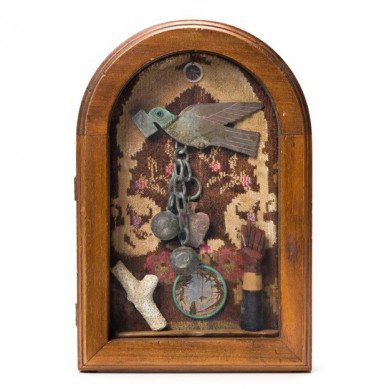Black History Month: Professor Maryann Wrinn Spotlights African American Arts Influence
This year’s Black History Month theme, African Americans and the Arts, “explores the key influence African Americans have had in the fields of “visual and performing arts, literature, fashion, folklore, language, film, music, architecture, culinary and other forms of cultural expression.”
Our own Professor of Art, Maryann Wrinn, shares her acclaim for African American artist, Betye Saar.
“Betye Saar is a printmaker, mixed media artist, and a storyteller. When I first saw her work, I recognized a visual kinship in our mutual admiration of the artist Joseph Cornell and his found object assemblages and our love of printmaking.
In addition to our foundational technical and process similarities, I greatly admire the cultural, autobiographical, spiritual, and political messages communicated through the personal iconography in her work.”
Who is Betye Saar?
"As one of the artists who ushered in the development of Assemblage art, Betye Saar’s practice reflects on African American identity, spirituality, and the connectedness between different cultures. Her symbolically rich body of work has evolved over time to demonstrate the environmental, cultural, political, racial, technological, economic, and historical context in which it exists.”
“For over six decades, Saar has created assemblage works that explore the social, political, and economic underpinnings of America’s collective memory. She began her career at 35, producing work dealing with mysticism, nature, and family. Saar’s art became political in the 1970s namely with the assemblage The Liberation of Aunt Jemima in 1972. As did many of the women who came to consciousness in the 1960s, Saar takes on the feminist mantra “the personal is political” as a fundamental principle in her assemblage works. Her appropriation of black collectibles, heirlooms, and utilitarian objects are transformed through subversion, and yet given her status as a pioneer of the Assemblage movement, the impact of Saar’s oeuvre on contemporary art has yet to be fully acknowledged or critically assessed. Among the older generation of Black American artists, Saar is without reproach and continues to both actively produce work and inspire countless others.”
Source: Roberts Projects
Betye Saar, Sojourn, mixed media assemblage in a wooden box, 1995
“In her exhibition essay, LeFalle-Collins notes how Saar uses the plush surface of the tapestry in Sojourn to construct an intimate interior and a spiritual space. The striking central imagery of the messenger bird flying while shackled in chains symbolizes the obstacles faced by African Americans in their pursuit of freedom. “ 
“Almost all was gathered on salvage campaigns to antique shops, swap meets, flea markets and rubbish bins, local and international. “I consider myself a recycler,” Ms. Saar says. (She’s also called herself a “junkie.”) “I’ve been that way since I was a kid, going through trash to see what people left behind. Good stuff.” Betye Saar
Source: Swan Art Galleries

